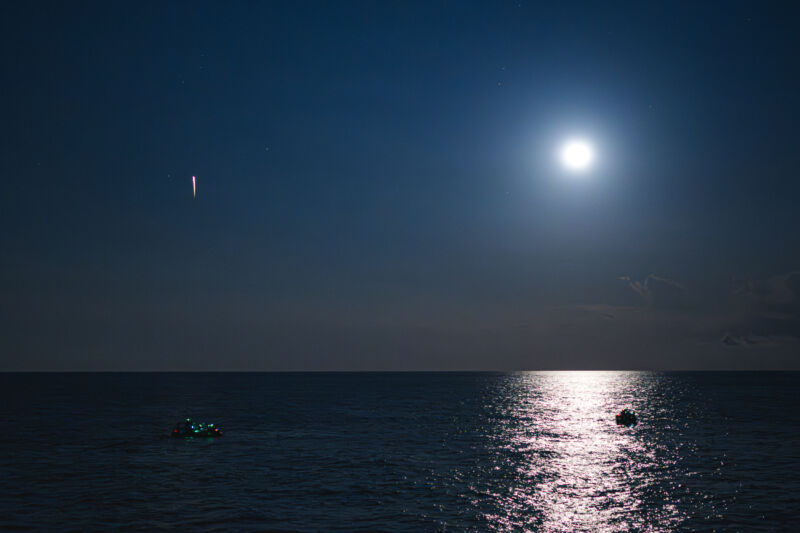

SpaceX
A white spacecraft, lightly toasted like a marshmallow and smelling of singed metal, fell out of the night sky early on Sunday morning and splashed down in the Gulf of Mexico not all that far from Key West.
The darkened waters there were carefully chosen from among dozens of potential landing spots near Florida. This is because the wind and seas were predicted to be especially calm and serene as the Crew Dragon spacecraft named Resilience floated down to the sea and bobbed gently, awaiting the arrival of a recovery ship.
Inside waited a crew of four—Commander Jared Isaacman, a billionaire who funded the mission and had just completed his second private spaceflight; SpaceX engineers Sarah Gillis and Anna Menon, who were the company’s first employees to fly into orbit; and Pilot Kidd Poteet.
They were happy to be home.
“We are mission complete,” Isaacman said after the spacecraft landed.
A significant success
Their mission, certainly the most ambitious private spaceflight to date, was a total success. Named “Polaris Dawn,” the mission flew to an altitude of 1,408.1 km on the first day of the flight. This was the highest Earth-orbit mission ever flown, and the furthest humans have traveled from our planet since the Apollo missions more than half a century ago.
Then, on the third day of the flight, the four crew members donned spacesuits designed and developed within the last two years. After venting the cabin’s atmosphere into space, first Isaacman, and then Gillis, spent several minutes extending their bodies out of the Dragon spacecraft. This was the first-ever private spacewalk in history.
Although this foray into space largely repeated what the Soviet Union, and then the United States performed in the mid-1960s, with tethered spacewalks, it nonetheless was significant. These commercial spacesuits cost a fraction of government suits, and can be considered version 1.0 of suits that could one day enable many people to walk in space, on the Moon, and eventually Mars.

The crew of Polaris Dawn calls back to SpaceX’s headquarters in Hawthrone, California, on Saturday.
SpaceX
Finally, on the mission’s final full day in space Saturday, the Dragon spacecraft demonstrated connectivity with a mesh of Starlink satellites in low-Earth orbit. The crew held a 40-minute, uninterrupted video call with flight operators back at SpaceX’s headquarters in Hawthorne, California. During that time, according to the company, Dragon maintained contact via laser links to Starlink satellites through 16 firings of the spacecraft’s Draco thrusters.
This test demonstrated the viability of using the thousands of Starlink satellites in orbit as a means of providing high-speed internet to people and spacecraft in space.
Wait, isn’t this just a billionaire joyride?
Some people have misunderstood the mission. They saw in Isaacman a financial tech billionaire gratifying his desire to go to space, inside a crew vehicle built by Elon Musk’s rocket company SpaceX. Thus, this appeared to be just a roller coaster ride for the ultra-rich and famous—for those who could not sate their thrill-seeking with the pleasures attainable on planet Earth.
I understand this viewpoint, but I do not share it.
The reality is that Isaacman and his hand-picked crew, which included two SpaceX employees who will take their learnings back to design spacecraft and other vehicles at the company, trained hard for this mission over the better part of two years. In flying such a daring profile to a high altitude through potential conjunctions with thousands of satellites; and then venting their cabin to perform a spacewalk, each of the crew members assumed high risks.
For its Crew Dragon missions that fly to and from the International Space Station, NASA has an acceptable “loss-of-crew” probability of 1-in-270. But in those spaceflights the crew spends significantly less time inside Dragon, and flies to a much lower and safer altitude. They do not conduct spacewalks out of Dragon. The crew of Polaris Dawn, therefore, assumed non-trivial dangers in undertaking this spaceflight. These risks assumed were measured rather than reckless.
So why? Why take such risks? Because the final frontier, after nearly seven decades of spaceflight, remains largely unexplored. If it is human destiny to one day expand to other worlds, and eventually other stars, we’re going to need to do so with more than few government astronauts making short sorties. To open space there must be lower cost access and commercial potential.
With his inventive and daring Polaris Dawn mission, Isaccman has taken a step toward such a future, by pushing forward the performance of Dragon, and accelerating SpaceX’s timeline to develop low-cost spacesuits. Certainly, Isaacman had a blast. But it was for a very good cause. He was lucky enough to go first, but through his actions, he aims to blaze a trail for multitudes to follow.